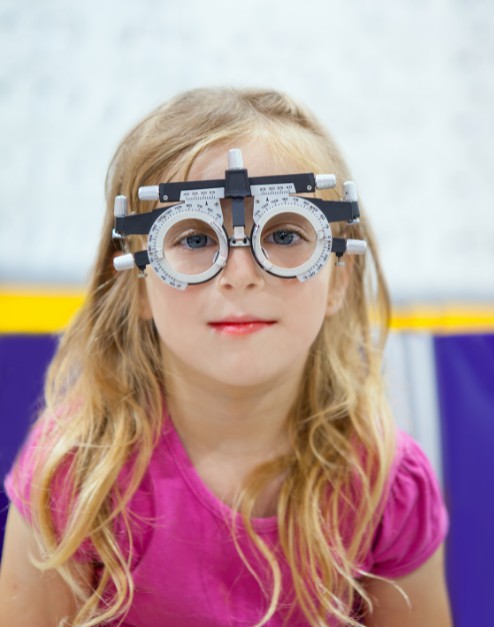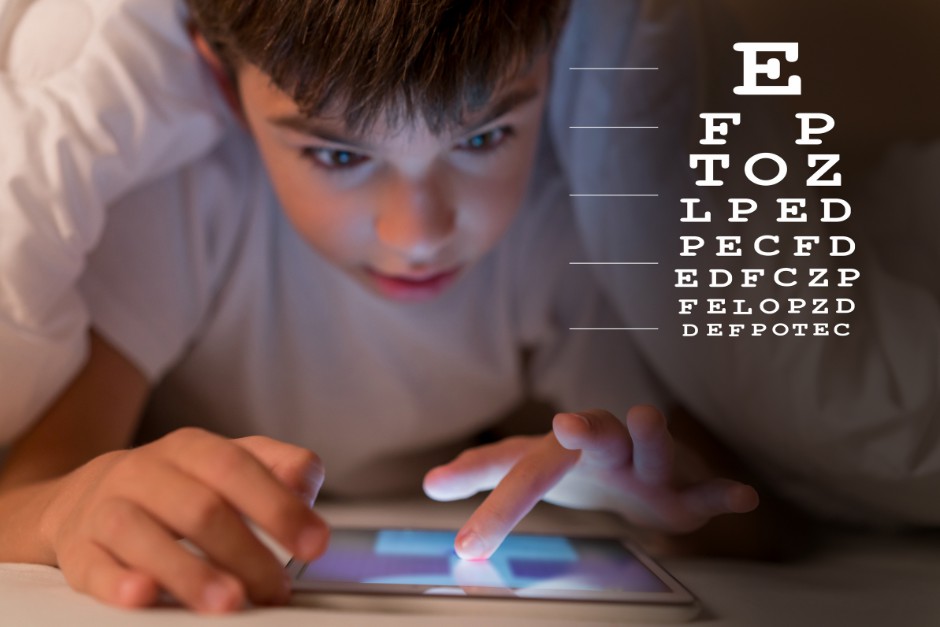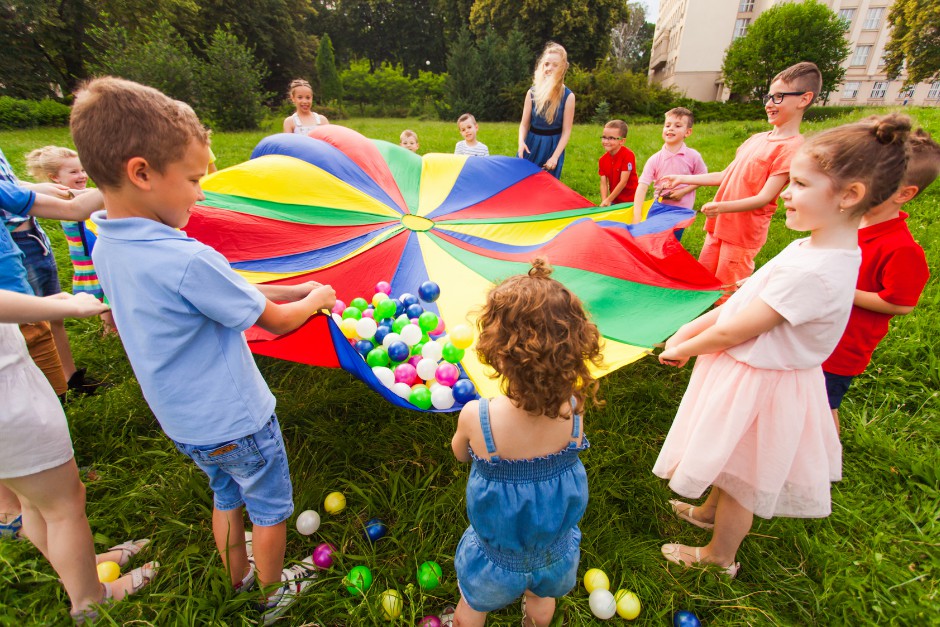From an infant to an adult, the changes keep happening in every inch of our skin, and of course including the vision. People don’t have a clear vision as long as they were born, as it takes time to grow up. During the growth and development of children, their vision can be vulnerable and easily affected by a lot of factors. For instance, children before 7 years old are likely to get strabismus, as well as farsightedness, nearsightedness, astigmatism, and amblyopia, and these situations need to be found and treated timely in order to avoid permanent vision loss. This is also why good behaviors of eye use should be fostered as soon as possible in childhood.

Common Eye Conditions in Childhood
As children’s eyes are still in the process of growth and development, there are certain eye conditions that are more common in children, including three main refractive errors (farsightedness, nearsightedness, and astigmatism), strabismus, and amblyopia. All these vision problems might be caused by improper eye use during childhood. In the meantime, some of these problems don’t have obvious symptoms and the children may be too young to tell their parents how their vision changes, which can lead to more severe results.
The three main refractive errors show different symptoms as follows:
- Farsightedness: blurry vision, distant objects are seen more clearly than nearby objects.
- Nearsightedness: blurry vision, the opposite of farsightedness, nearby objects can be seen more clearly than distant objects.
- Astigmatism: blurry or distorted vision whether seeing nearby or distant objects, and being difficult to see at night.
 It’s common to have more than one type of refractive errors at the same time, and they can usually be corrected with glasses. However, if left untreated, children would meet more uncomfortable symptoms like headaches or eye pain during their growth. Or, children can lose their vision and develop amblyopia if they don’t use their eyes correctly for an extended period of time.
It’s common to have more than one type of refractive errors at the same time, and they can usually be corrected with glasses. However, if left untreated, children would meet more uncomfortable symptoms like headaches or eye pain during their growth. Or, children can lose their vision and develop amblyopia if they don’t use their eyes correctly for an extended period of time.
Amblyopia, also known as lazy eye, is the most prevalent cause of visual loss in children, and it begins in childhood. It’s a condition of poor eyesight that typically affects only one eye but less frequently both. It occurs when there is a breakdown in the interaction between the brain and the eyes, and the brain is unable to recognize the sight coming from only one eye. The situation of the weaker eye’s vision will get worse and worse as the brain begins to rely more and more on the other, stronger eye.
It’s a usual situation that people meet multiple types of eye conditions in their childhood. The difficulty comes from that the children may not be able to express their vision problems clearly and the symptoms are often unobvious. This is why regular eye exams matter for children. Furthermore, some types of eye infections are popular in childhood as well, since it’s hard for kids to notice eye hygiene all the time.
Why Can Being Outdoors Improve Good Vision?
Vision problems are really not rare in childhood. There are a lot of improper behaviors can harm children’s vision and lead to certain eye issues. In this case, raising a child is not easy at all, especially if parents want to totally keep their children healthy. And this is why children need to be guided during their growth and development. In order to maintain eye health and improve good vision, increasing the time of outdoor activities can be particularly helpful.

Many studies prove that being outdoors for at least 60 minutes every day can be helpful for kids to develop good vision and improve their eye health. The elements that come from the nature like lights, colors, air, trace elements and so on, can be meaningful to irritate eye development and practice the functions of eyeballs somehow. To be more specific, the benefits to the eyes of outdoor activities can be summarized in the following aspects:
 Reduced screen time. In the modern era of rapid technological development, digital devices become something crucial to people’s lives, and they also appear more and more frequently in the field of education. Some parents may not have enough time to accompany their children, so they use a digital product to play cartoons or some educational videos and just leave it to their kids. While this kind of situation can increase the risk of children’s eye issues without any doubts. In this case, everyday outdoor activities can at least reduce some time of staring at the digital screens in order to protect children’s vision.
Reduced screen time. In the modern era of rapid technological development, digital devices become something crucial to people’s lives, and they also appear more and more frequently in the field of education. Some parents may not have enough time to accompany their children, so they use a digital product to play cartoons or some educational videos and just leave it to their kids. While this kind of situation can increase the risk of children’s eye issues without any doubts. In this case, everyday outdoor activities can at least reduce some time of staring at the digital screens in order to protect children’s vision.- Practice eye functions. Kids hardly stare at only one object during the time that they’re playing outdoors. Outdoor activities always provide a wider area for children to explore and observe. This would allow them to switch their eye function to see near or far. It’s a process of practicing the lens of the eyes, which can definitely practice eye functions in order to improve the growth of children’s eyes, and reduce the risk of getting farsightedness or nearsightedness.
 Natural scenery is good for eye health. A benefit that might be ignored sometimes is the natural scenery can also contribute to vision health. Nature might be the first place that comes to our mind if we want to somewhere full of green plants. According to relevant research, our eyes are able to quickly recognize the wavelengths that correlate to the color green, which promotes relaxation. This is the reason that people usually find it calm and peaceful when they are close to the nature.
Natural scenery is good for eye health. A benefit that might be ignored sometimes is the natural scenery can also contribute to vision health. Nature might be the first place that comes to our mind if we want to somewhere full of green plants. According to relevant research, our eyes are able to quickly recognize the wavelengths that correlate to the color green, which promotes relaxation. This is the reason that people usually find it calm and peaceful when they are close to the nature.- Proper irritation to the eyes. As the important organs in human’s body, the eyes consist of abundant structures and nerves. Every detailed structure of the eyes needs to be developed properly during the growth of a child, so the child could grow up with healthy eyes and good vision. Thus, being outdoors helps children acquire multiple elements their eyes might need, so the eyes can get proper irritation to improve development at the same time.
Tips for Children When Joining Outdoor Activities
Being outdoors can be helpful to develop children’s eyes, but moderate time and appropriate eye protection may matter in the meanwhile. To improve children’s vision health by joining outdoor activities, there are some precautions shall be noticed.
 Eye protection during outdoor activities. When children are joining outdoor activities, it’s truly essential to avoid playing in places with strong sunlight. Although the lights from nature can be beneficial to the eyes, excessively bright sunlight is not advisable. In these circumstances, it’s better for the kids to choose somewhere without strong sunlight to play, or to wear a pair of sunglasses to protect their eyes.
Eye protection during outdoor activities. When children are joining outdoor activities, it’s truly essential to avoid playing in places with strong sunlight. Although the lights from nature can be beneficial to the eyes, excessively bright sunlight is not advisable. In these circumstances, it’s better for the kids to choose somewhere without strong sunlight to play, or to wear a pair of sunglasses to protect their eyes.- A natural environment with green plants is the first option. When choosing places for children’s outdoor activities, a place that is close to nature or with green plants shall be the priority. Being close to nature brings not only benefits to the eye health but also advantages to the overall health of a child. Natural places like mountains or parks can all be good choices, and it’s a way to help children know more about the world as well.
 Remember to look far. As one of the purposes of being outdoors is to practice the eye function, it’s important to remind children look more on the further objects. Compared with indoor spaces, outdoor places often offer wider areas for children to see. In this case, trying to look far in the outdoor places can be useful to practice their eye functions.
Remember to look far. As one of the purposes of being outdoors is to practice the eye function, it’s important to remind children look more on the further objects. Compared with indoor spaces, outdoor places often offer wider areas for children to see. In this case, trying to look far in the outdoor places can be useful to practice their eye functions.- 60 minutes of outdoor time. While contributing to the eye growth and development of children, it’s necessary to make sure they spend enough time outdoors. Therefore, children are able to get enough elements that can be used to improve their growth. The recommended time of being outdoors is usually about 60 minutes every day due to some research. It’s a moderate time for children to get benefits that are good for their growth.
The International Agency for the Prevention of Blindness (IAPB) has calculated the number of children with vision loss all over the world that is up to 450 million, and at least 90 million children are suffering from a type of vision loss. In order to help these children adapt to low vision life, the assistive technology like Zoomax Snow 12 or Luna 6 can be perfect choices as they provide powerful functions and ideal size to meet children’s demands. American customers can visit our official US website to get information about more low vision aids for your visually impaired kids.
References:
https://opto.ca/eye-health-library/playing-outdoors-can-help-maintain-childrens-eyesight
https://www.optimax.co.uk/blog/being-nature-boost-eye-health/
https://www.aao.org/eye-health/tips-prevention/common-childhood-diseases-conditions
https://www.aao.org/eye-health/tips-prevention/children-vision-development
https://www.iapb.org/learn/vision-atlas/magnitude-and-projections/child-eye-health/

